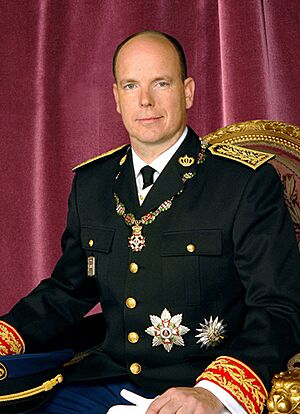Albert II, Prince of Monaco facts for kids
Quick facts for kids Albert II |
|||||
|---|---|---|---|---|---|
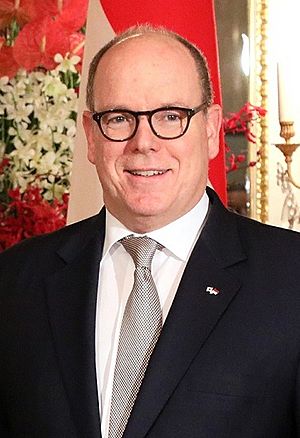
Albert II in 2019
|
|||||
| Prince of Monaco | |||||
| Reign | 6 April 2005 – present | ||||
| Predecessor | Rainier III | ||||
| Heir apparent | Jacques | ||||
| Ministers of state |
See list
Patrick Leclercq
Jean-Paul Proust Michel Roger Gilles Tonelli (acting) Serge Telle Pierre Dartout Didier Guillaume Isabelle Berro-Amadeï (acting) Christophe Mirmand |
||||
| Regent of Monaco | |||||
| Tenure | 31 March – 6 April 2005 | ||||
| Monarch | Rainier III | ||||
| Born | 14 March 1958 Prince's Palace of Monaco, Monaco |
||||
| Spouse | |||||
| Issue | Jazmin Grace Grimaldi (illegitimate) Alexandre Grimaldi-Coste (illegitimate) Princess Gabriella, Countess of Carladès Jacques, Hereditary Prince of Monaco |
||||
|
|||||
| House | Grimaldi-Polignac | ||||
| Father | Rainier III, Prince of Monaco | ||||
| Mother | Grace Kelly | ||||
| Religion | Roman Catholicism | ||||
| Signature | |||||
| Military career | |||||
| Allegiance | |||||
| Service/ |
|||||
| Years of service | 1986–2005 (end of active service) |
||||
| Rank | Commander-in-chief | ||||
Albert II (born Albert Alexandre Louis Pierre Grimaldi on 14 March 1958) is the current Prince of Monaco. He has been the ruler of Monaco since 2005.
Prince Albert was born at the Prince's Palace of Monaco. He is the second child and only son of Prince Rainier III and Princess Grace. He went to Lycée Albert Premier and later studied political science at Amherst College in the United States. When he was younger, he competed in bobsleigh at the Winter Olympics. He stopped competing in 2002.
In March 2005, Albert became regent after his father became ill. He became the Prince of Monaco a week later when his father passed away. Since becoming Prince, he has been a strong supporter of protecting the environment. He works to save the ocean and promote renewable energy to fight climate change. In 2006, he started the Prince Albert II of Monaco Foundation. This foundation raises money and takes action to protect the environment.
In 2010, Prince Albert's wealth was estimated at US$1 billion. He owns parts of the company that runs Monaco's casino and other fun places. In July 2011, Prince Albert married Charlene Wittstock, an Olympic swimmer from South Africa. He has four children: Jazmin, Alexandre, Gabriella, and Jacques.
Contents
Early Life and Family

Prince Albert was born at the Prince's Palace of Monaco on 14 March 1958. He was the second child of Prince Rainier III and Princess Grace. From birth, he was the heir to the throne of Monaco. He was also a citizen of both Monaco and the United States. He later gave up his American citizenship.
He was baptized on 20 April 1958. His godparents were Prince Louis de Polignac and Queen Victoria Eugenie of Spain. Prince Albert's mother, Princess Grace, passed away in 1982 after a car accident. Prince Albert has shared that her death was a very difficult time for his family.
Education and Military Service
Before going to college, Albert spent a year learning about his royal duties. In 1977, he enrolled at Amherst College in Massachusetts. He studied political science and graduated in 1981. He can speak French, German, Italian, and English.
From 1981 to 1982, Albert trained with the French Navy. He served on the helicopter cruiser Jeanne d'Arc. He reached the rank of Ship-of-the-Line Ensign (2nd class). He is now a reserve Lieutenant Commander. From 1983 to 1985, he took business courses in the United States and Europe. He learned about money management, communication, and marketing.
Since 1993, Prince Albert has led Monaco's group at the General Assembly of the United Nations. In 2004, he led Monaco's group when the Principality joined the Council of Europe.
Sports Career
| Sport | |
|---|---|
| Country | |
| Sport | |
| Event(s) | 4-man, 2-man |
| Retired | 2002 |
| Achievements and titles | |
| Olympic finals | 1988, 1992, 1994, 1998, 2002 |
Prince Albert is a very active sportsman. He has participated in many sports, including cross country, javelin throwing, handball, judo, swimming, tennis, rowing, sailing, skiing, squash, and fencing. He earned a judo black belt in 1985.
Albert competed in bobsleigh at five Winter Olympics for Monaco. He took part in both the two-man and four-man events. He was Monaco's flag bearer at the 1988, 1994, and 1998 Winter Olympics. He also participated in the 1985 Paris–Dakar Rally.
He has been a member of the International Olympic Committee since 1985. His grandfather, John B. Kelly Sr., and uncle, John B. Kelly Jr., were both Olympic medalists in rowing.
On 31 March 2005, Prince Albert took over his father's duties as regent. This happened because his father, Prince Rainier, was no longer able to perform his royal tasks.
Becoming Prince of Monaco
Prince Albert II officially became the ruler of Monaco in two parts. The first part was on 12 July 2005, after a three-month mourning period for his father. A morning church service at Saint Nicholas Cathedral marked the start of his reign. After the service, Albert hosted a party for 7,000 people born in Monaco. He received two keys to the city, a symbol of his new role, and gave a speech. The day ended with fireworks.
The second part of his enthronement was on 19 November 2005. Albert was formally crowned at Saint Nicholas Cathedral. Many members of the Princely family were there. Royalty from 16 other countries also attended the celebrations. The evening ended with a special performance at the Opéra de Monte-Carlo.
Succession to the Throne
As Prince Rainier III's health declined, people wondered about Albert's lack of legitimate children. This was important because of Monaco's laws and international agreements. Before 2002, Monaco's constitution said that only the Prince's "direct and legitimate" children could inherit the crown.
In 2002, Monaco changed its law. It now says that if a reigning prince dies without legitimate children, the throne goes to his legitimate siblings and their legitimate children. This includes both sons and daughters, with sons preferred.
Prince Albert has two children born outside of marriage: Jazmin Grace Grimaldi and Alexandre Grimaldi-Coste. They are not in the line of succession to the Monegasque throne because they are not considered legitimate under Monegasque law. Prince Albert has confirmed this.
Prince Albert and Princess Charlene had twins on 10 December 2014: Princess Gabriella, Countess of Carladès, and Jacques, Hereditary Prince of Monaco. Jacques is the heir apparent to the throne. Before their birth, Prince Albert's elder sister, Caroline, Princess of Hanover, was next in line. She is now third in line.
Princely Activities and Reforms
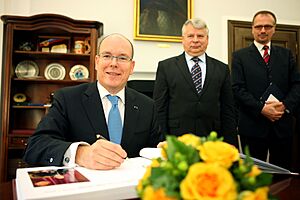
In the early years of his reign, Prince Albert made many changes to Monaco's laws. These changes included rules about custody, protecting people's privacy with new technology, freedom of the press, equal rights for men and women, and protecting children's rights.
In July 2005, Prince Albert traveled to Spitsbergen, Norway, following in the footsteps of his great-great-grandfather, Albert I. He visited glaciers there. Prince Albert also went on a Russian Arctic expedition, reaching the North Pole on 16 April 2006. This made him the only current head of state to have visited both the North and South Poles.
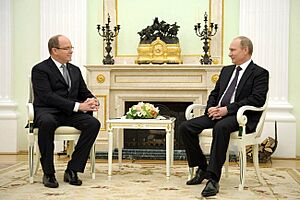
Since becoming Prince, he has overseen the building of new community facilities. These include social housing, railway lines, schools for the hospitality industry, and high schools. He also leads efforts to promote ethical business, fight money laundering and organized crime, and make tax fraud a crime in Monaco.
In 2006, Prince Albert created the Prince Albert II of Monaco Foundation. This foundation supports projects around the world that are good for the planet and people. The foundation focuses on three main goals: fighting climate change and developing renewable energy, stopping the loss of different types of plants and animals, and making sure everyone has access to clean water.
On 27 August 2015, Prince Albert apologized for Monaco's role in sending 90 Jewish people and resistance fighters to the Nazis in 1942. Only nine of them survived. He said that Monaco "committed the irreparable" by handing over people who had sought safety there. A monument to the victims was unveiled at the Monaco Cemetery.
Personal Life
In 2016, Albert bought his mother Princess Grace's childhood home in East Falls, Philadelphia. Her father, Jack Kelly Sr., built the house. Prince Albert said the house might become a museum or offices for the Princess Grace Foundation. Prince Albert does not directly own the Prince's Palace. However, he has personal homes in La Turbie and Marchais.
Prince Albert enjoys cars and owns several eco-friendly vehicles. He also owns a Dassault Aviation Falcon 7X, which is a private jet.
On 19 March 2020, during the COVID-19 pandemic in Europe, it was announced that Albert II had tested positive for COVID-19. He was the first monarch and head of state to get the virus. He recovered fully by 31 March. In April 2022, he tested positive again and self-isolated briefly.
In 2021, Raphaël Domjan became the first pilot to fly an electric plane with a head of state. On 14 September 2021, they flew a Pipistrel Velis128 from Nice airport with Albert II. They flew over Monaco for 30 minutes.
Marriage and Children
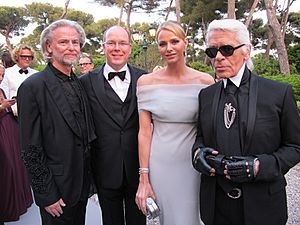
Prince Albert first met South African swimmer Charlene Wittstock in 2000. They made their first public appearance as a couple at the opening ceremony of the 2006 Winter Olympics.
Their engagement was announced on 10 June 2010. They were married in a civil ceremony on 1 July 2011 at the Prince's Palace. The religious ceremony took place the next day, 2 July. The couple spent their honeymoon in South Africa and Mozambique.
Prince Albert and Princess Charlene welcomed twins, Princess Gabriella, Countess of Carladès, and Jacques, Hereditary Prince of Monaco, on 10 December 2014. Prince Jacques is the heir apparent to the throne of Monaco.
Charity Work and Environmental Efforts

Prince Albert supports many organizations. He is a patron of AS Monaco, the World Olympians Association, and the Monaco Red Cross. He also holds honorary presidencies for groups like the Automobile Club de Monaco.
Protecting the Environment
Prince Albert is very passionate about protecting the environment. In 2001, he was chosen to lead the Mediterranean Science Commission. In 2007, he was the International Patron for the "Year of the Dolphin." He said this was a chance to renew his commitment to protecting marine life.
The Zoological Garden of Monaco was started by Prince Rainier in 1954. Prince Albert plans to change it into a zoo for children.
In January 2009, Prince Albert went on a month-long trip to Antarctica. He visited many scientific stations and met with experts on global warming. He wanted to learn more about how climate change affects the continent. During this trip, he reached the South Pole.

In June 2009, Prince Albert wrote an article for The Wall Street Journal with environmental journalist Charles Clover. They wrote about how bluefin tuna are being overfished in the Mediterranean Sea. Albert also announced that Monaco would try to list the Mediterranean bluefin as an endangered species. This was a big step, as it was the first time a nation had done this since 1992.
On 16 July 2009, France and the United Kingdom also decided to try and list the Mediterranean bluefin as an endangered species.
In 2017, Prince Albert showed great interest in a plan for a Global Pact for the Environment. He said it would be a "universal, legally binding agreement" that recognizes the right of future generations to a healthy planet.
In 2021, Prince Albert worked with Torres Strait Islander artist and activist Alick Tipoti on a film called Alick and Albert. This documentary is about the future of the oceans and how climate change affects people in the Torres Strait Islands and Monaco.
On 12 February 2020, Albert and Victor Vescovo reached the bottom of Calypso Deep in a submarine. This is a very deep part of the ocean. They were only the second team to do this.
Titles and Awards
| Styles of Albert II |
|
|---|---|
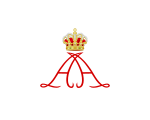 |
|
| Reference style | His Serene Highness |
| Spoken style | Your Serene Highness |
Titles and Styles
- 14 March 1958 – 16 March 1958: His Serene Highness The Hereditary Prince of Monaco
- 16 March 1958 – 6 April 2005: His Serene Highness The Hereditary Prince of Monaco, Marquis of Baux
- 31 March – 6 April 2005: His Serene Highness The Prince Regent of Monaco
- 6 April 2005 – present: His Serene Highness The Prince of Monaco
Awards and Recognition
Prince Albert has received many awards for his work. In 1996, he received the Eagle Award from the United States Sports Academy. This award recognized his efforts to promote peace and goodwill through sports.
On 23 October 2009, he received the Roger Revelle Prize for his work in protecting the environment and supporting scientific research. This award was given by the Scripps Institution of Oceanography.
In October 2017, Prince Albert received the Lowell Thomas Award from The Explorers Club. This award honored his dedication to environmental protection and his achievement of being the first head of state to reach both the North and South Poles.
In 2019, he received an honorary doctorate from Comenius University in Bratislava. This was for his work in protecting natural and cultural heritage and fighting climate change.
Images for kids
See also
 In Spanish: Alberto II de Mónaco para niños
In Spanish: Alberto II de Mónaco para niños
- Legion of Honour
- List of royal Olympians


